| |
ON THIS SIDE OF PYANDJ
Preface
Chapter 1. THE KINKING WAY TO THE CAPITAL OF THE PAMIRS
Chapter 2. THE STORY REPEATS
Chapter 3. STRONGHOLDS OF THE WAKHAN VALLEY
Chapter 4. PAMIRIS AND BADAKHSHANIS
Chapter 5. AFGHAN BANK IS OF NO NEED TO YOU
Chapter 6. GOING HOME
CHAPTER 3. STRONGHOLDS OF THE WAKHAN VALLEY

In his book ‘The Description of the World’ Marco Polo wrote once, ‘There are many narrow passes and inaccessible places in this kingdom, and therefore the people are not afraid of the enemy’s attacks. Their cities and fortresses are situated on high mountains, in inaccessible places’.
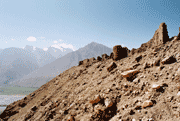 |
|
According to legends, in immemorial times the fire-worshippers Aryans tried to defend the fertile lands of the Pamirs mountains from the attacks of the tribes who lived on the left bank of the Pyandj and built the whole net of fortresses. The northernmost one was located near the junction of the Pamir and the Wakhandarya rivers, and the southernmost one was not far from Ishkashim. It is considered that one of the most important constructions of the time was the fortress Yamchun also called as Kyafir-Kala or Zamor-i-Otash-parast. It was that place that we intended to go to when moving to the Wakhan valley. Even on the expiry of two thousand years this place has not lost its strategic importance. The so called Wakhan corridor, a stripe of Afghan territory which is not more than 20 kilometers here and there, once designed to being a buffer zone between the possessions of the Russian and British Empires, has always attracted rapt attention of the military men and politicians.
I cannot say that I liked our way from Khorog to Ishkashim very much. We happened to run into a company of not quite decent guys at the bus station, who later turned out to be drug addicts and frauds. First we agreed at one price, but then in Ishkashim we even had to pay more. Not willing to get to the truth and know who of them was really light-fingered and who was honest-minded, we tried to forget these people as soon as possible and jumped into a small UAZ-lorry going to Yamchun.
I liked this trip in the body of the lorry best of all. I will not be cunning, I got to the body only to keep my eye on our stuff ( Lena stayed in the cab), because after being disappointed in people just half an hour before that, I did not want to make my own mistakes again. But later I understood that such trips are valuable for they give the opportunity to communicate with local people, good-natured and friendly men. Several hours passed while we were speaking about who we were and where we were from, and there were permanent invitations to drop in on somebody, treating and a lot of other pleasant moments.
I should say that we went to Wakhan with a German traveler named Herbert. We met him in an Internet-cafe in Khorog and learnt that he had managed to cycle from Dushanbe to Karakul, and had got back to Khorog by car. Finally, he planned to go to the Wakhan valley. So, our intentions coincided, and in the morning at the bus station we had the same purpose. Having arrived at Yamchun, we helped him find a place to spend a night at, and the following days we met him with enviable constancy, even not supposing to see each other again every time.
So, at about five in the evening, we saw the remnants of the ancient towers and walls stretching hundreds of meters along the range of the mountain. As I realized later, this was the wall leading from the main fortress to the remote outpost situated much lower than the main citadel. And an hour later, having passed a picturesque fall and drunk water from the spring we got to the point from which one could observe the Yamchun fortress in all its magnificence.
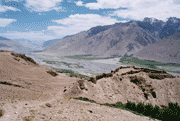 |
Wakhan Valley,
the Pyandj River
|
Nobody really knows when and by whom Yamchun Fortress was built because legends in the Wakhan Valley are closely intertwined with reality, and it is sometimes almost impossible to separate them from true life. The most popular story tells about three brothers from the clan of fire-worshippers, the Siyakhpushes (which can be translated as ‘black caps’): Kaahka, the most well-known brother after whom the fortress next to kishlak Namatguti-Poyon had been named; Zengibar who possessed the fortress Khisor situated not far from the kishlak Zong, and, finally, Zulkhasham who was the owner of Yamchun. They say that the three legendary brothers, using the force of the garrisons of their fortresses, showed long and stubborn resistance to the Arabian invaders headed by prophet Ali himself. Tales about Ali prove the legendary basis of the local history one more time, for there are no historical data saying that prophet Mohammed’s son-in-law and one of Shiite imams reached Wakhan in his campaigns.
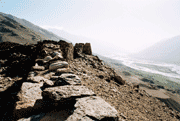 |
Stones of ancient fortress
|
Moreover, according to the information available, today’s Wakhan Valley was conquered by the Arabs and included into Arab Caliphate only in the 8-9th centuries, while Ali (quite certainly) died in 661, that is to say at least 40 years before the events described. There is also another legend connected with the Siyakhpushes, telling about countless treasures which are said to have been hidden by them during the Arabian invasion in Mata-Tash cave, in the area of Rangkul (northwards from present-day Murghab).
If applied to Namatgut, these legends are historically true (for that fortress was built just between the sixth and eighth centuries A.D.). But Yamchun, according to archaeological data, is much older than the legends about the three brothers, because it is believed to have been erected in the end of the first millennium B.C. History tells us about Greco-Bactrian kingdom existing in the region being described, and of the Kushan Empire that had been created later on its ruins. This temporal period approximately corresponds to the age of Yamchun Fortress. Though, the truth is buried in the darkness of centuries… As I was said, the Persian name of Yamchun, Zamor-i-Otash-parast can be translated as ‘the fortress of fire-worshippers’. This name is confirmed by archaeologists who prove that once there was a Zoroastrian temple in the territory of the fortress.
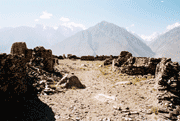 |
|
Maybe, seeing Yamchun struck me so much because the dream of my childhood had been finally realized. And the panorama from the walls of the fortress viewing two sides of the Wakhan Valley and snow-covered peaks of Hindu Kush amazed me in their entire drooping beauty. Soundtrack to ‘Indiana Jones’ sounded distinctly in my head, and my mind refused to believe that there are still some places on earth where antiquities are not fenced in by netting and burdened by ticket-men and excursion-guides. We pitched our tent just inside the ancient fortress and this fact evoked storm of emotions in me.
In Yamchun I felt real pioneer, even being fully aware that it is not so. The dream of the Wakhan Valley became reality, and this reality was much more wonderful than the dream itself.
The next morning, having organized a small photo session in the fortress, we moved towards the thermal spring Bibi Fotima. As any other place in the Pamirs, this spring is associated with the prophet Mohammed’s family, and it indeed possesses miraculous qualities even if not taking into account all legends connected with it. The temperature of water in the spring exceeds 40 degrees centigrade during the whole year. Containing radon and lots of other useful elements, it is used to treat numerous diseases.
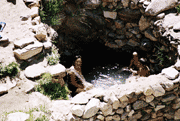 |
Bibi Fotima thermal spring
|
On our way to the spring we met Herbert who had already got his doze of radon water for 5 somons and, excited, was going back to the sanatorium. But I should say that a piece of health can be received free of charge, and even without awaiting in queue. We were informed about it by a local guy. It turned out, that if you pass some more 500 meters across the hill aside from the legal building, you will find rather democratic (that is without sexual separation) body for bathing. The spring existed there even before the house had been built with separate baths for men and women. It was in this old spring surrounded by bare stones where Lena took a bath together with children from the neighboring kishlak. I had no desire to get into hot water in such heat, so I preferred to wet my feet in a cold mountain river.
Director of the sanatorium with whom I got acquainted when trying to arrange a night for Herbert shared with me his plans concerning development of tourism in Yamchun. He boasted that he was going to visit America to attend courses, where he would be taught a civilized way to run tourist business. Frankly speaking, I do not think that the so called ‘tourism development’ in Yamchun will have more positive consequences than negative ones. Moreover, the territory of the fortress would be fenced in; they would pave the road to its entrance, and next to a road there would sit a man who would collect money from those who would like to see this sight. And Lord forbid anyone to pitch a tent there for it is an important historical monument! It would cost more to bathe in the official thermal spring for foreigners (by the way, even now the price is at least ten times more for foreigners if compared with that for citizens of Tajikistan). And the old spring would be closed, so that people could not treat free of charge. And in these moments you realize that sometimes absence of development is good…
The day following after visiting the healing spring we were descending down the valley, every now and then stopping to speak to local people and refusing insistent offers to have a cup of tea. Those offers were very attractive indeed, but they threatened to confuse our walking spirit under pressure of a strong desire to relax and lie down near dastarkhan, a piala with tea in the hand. However, when in the afternoon we reached kishlak Ptup, we could not refuse a next proposal and never regretted it. The host of the house whose name was Gulyam turned out to be a local history teacher who could relate to us plenty of interesting facts about antiquities of the Wakhan Valley and history and essence of Ismailism. He told us about recent past when during the civil war (Gorno-Badakhshan took the part of Tajik opposition) the life of his relatives and of his own hung by a thread. Many of those who attempted to say something about democracy at that time did not survive till our days… Despite Gulyam’s insistent requests to stay for a night we bade farewell to the cordial hosts and continued on our journey.
Before it got dark we managed to pass kishlak Zumudg and reach the eastern border of the deserted area stretching southwestwards over 13 kilometers . Realizing that going farther we would not have a chance to seeing fuel for a bonfire and water for tea, we stopped for a night. Having pitched the tent, I was loitering about the vicinity with a camera for a long time, trying to capture the peaks of Marx and Engels that were picturesquely illuminated by the setting sun.
The morning after that night we made those mentioned 13 kilometers down the valley. After picturesque green and blue colors prevailing in the landscapes of Yamchun, it was somewhat unusual for us to see that brown and grey ground or sand literally covering Pyandj over the whole small desert, clouds of dust and absence of streams flowing everywhere.
Finally we got to kishlak Shitkharv, where, as we had been informed, there was a shop in which we could fill up our provisions, and where it was possible for us to get to a marshrutka going to Ishkashim. The data from the Internet proved to be true and, as it had been told, opposite the mazar in the southern part of Shitkharv we found a country-style department store where one can buy anything he likes. After drinking sweet fizzy water we made ourselves comfortable right at that place, opposite the mazar, in order to wait for a marshrutka or a car going to Ishkashim. The jingling ‘Raf’ did not keep us waiting for a long time, and at about the noon we were entering Ishkashim.
The way back from the Wakhan Valley to Khorog deserves being described in detail, primarily, due to two moments: the so called ‘chase of the German’ and our first encounter with the company in the Pamirs who drank beer.
Ishkashim ‘terminal’ that was playing the role of the local bus station was empty. The driver was obviously right when he told that nobody would have a desire to go to Khorog on Friday afternoon. The same was told by other people who added that it would be much easier to leave the next day because of the Saturday Afghan-bazaar, to which people arrived even from Khorog. But that day it was possible to leave only ‘on demand’, that is to say paying tariff for the whole car including the way back. That day we did not have a chance to get any passing transport, to which, by the way, usual marshrutkas are referred to there as well. Finally, after a few conversations with the local people we arrived at an idea that the only way-out was to find a German (we thought about Herbert at once) who was seeking for a car to Khorog some time before us. We could cooperate with him, thus decreasing the cost of the trip. There was also a variant to stay there, in Ishkashim. We already managed to get an invitation from a local fellow called Erkin, but we wanted so much to get to Khorog that very day because we planned to meet Andre who was going again to leave for somewhere.
Soon almost all the village was participating in search of the German traveler. As people who had seen him and who knew English, we were driven around the village by one of the possible taxi-drivers Atabek, asking everyone if they had met a foreigner. Almost everyone knew about the German. At last, we managed to find traces of him and learnt where he had stopped for the night. But, having arrived at the place, Atabek was disappointed to know from the hosts that the German had made up his mind to stay in Ishkashim until the next day and had already gone to bed. Atabek, however, decided to help us reach Khorog and found the guys who were going to Andarob located near the resort of Garm-Chashma. From there it was much easier to get to Khorog, because a lot of cars were moving towards the city from the resort. And in half an hour we were sitting in a ‘UAZ-tabletka’, listening to local music whose sounds were trying to clamor over the roar of the engine. When passing the bridge joining the Afghan and Tajik banks of the Pyandj I happened to see Herbert standing near a truck. Our ‘UAZ’ braked for a while, and I ran out to know how he was doing. He turned out to return to Ishkashim that day indeed, and the car, in whose basket he was now sitting, just stopped to transship some stuff. After that they were going to go to Khorog, too. Having wished good luck to each other, we parted.
As for me, the search of Herbert reminded movies about the Great Patriotic War, with their inherent, most sacramental question, ‘Granny, are there any Germans in the village?’ There was only one difference: everyone without exception knew that there was a German in the village. Of course, when I saw Herbert near Ishkashim bridge I understood that the people in the village meant some other German. Nevertheless, my imagination was showing scenes where Herbert had lulled the vigilance of his pursuers, climbed out the window down a rope-ladder and decided to get out of the encirclement at any price, by roundabout way.
At the post of GAI (traffic police) in Andarob we found a car going to Khorog, and the following way (which was rather exciting, by the way) we made in a company of three Pamiris and an Afghan who were returning from the resort of Garm-Chashma, rather popular among the local people. The guys of our age turned out to be very hospitable, and thanks to them on one of our last days in Gorno-Badakhshan we could finally taste pilaw in one of roadside cafes. I need to say that before that we were very surprised to know that this dish, characteristic of Asian peoples was not wide-spread in dining places of Khorog, but what was popular and therefore often cooked is goloubets (cabbage stuffed with minced meat) which I never tend to refer to Asian cuisine.
But what I liked in this company best of all was that all of them drank beer. Everyone who knows me is very well aware that this beverage is of great (almost sacred) importance for me. But there, in Gorno-Badakhshan, it was rather difficult to find a company to drink beer with (despite the rumor that Ismailism is very liberal towards drinking alcohol, those loving to drink could be met very seldom in Badakhshan). And, finally, the fate brought us together with like-minded people, I could say. In the company of Muslim, Safar, Manul and Nazar Lena and I were driving around the evening Khorog, drinking beer after our impressions of the recent days and thinking that the sense of holiday could be created in any place on earth. The most important is that your friends are by your side, and you have beer.
|



